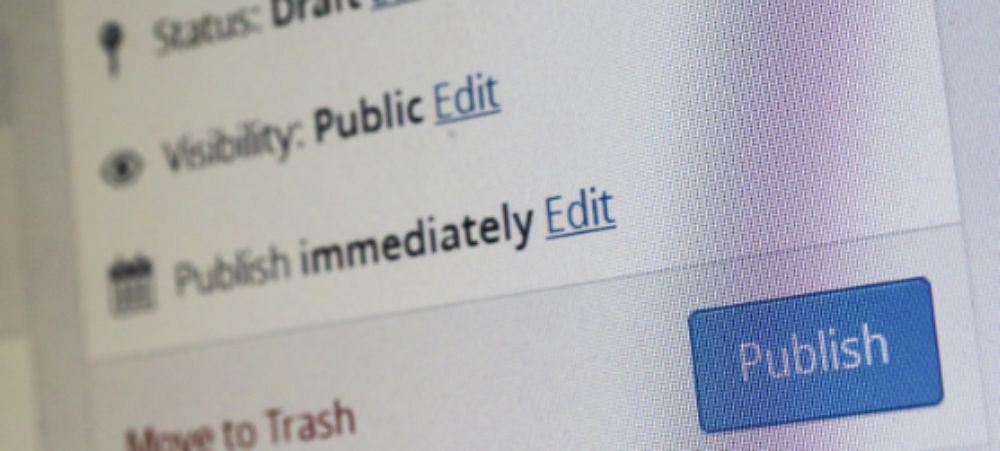Starting a blog can be a beneficial method for establishing credibility for your brand. Additionally, it offers a platform for self-expression, particularly if you have a passion for writing or want to document and share your hobbies with others.
Before starting a blog, it is important to be aware of certain strategies. That’s why we have created a comprehensive step-by-step guide for new bloggers to help them get started.
In this article, we will cover include finding a specific area of focus, setting up a blogging platform, publishing content, and promoting your blog.

How to Start a Blog in 10 Simple Steps
1. Pick Your Blog Niche

A niche is a specific topic that a blog focuses on, and it plays a crucial role in identifying the target audience. A well-defined blog niche can also assist in selecting an appropriate blog name and developing a focused blogging strategy.
Some common blog niches are books, travel, gaming, photography, and food.
When creating a new blog, it is advisable to narrow down the focus to a specific niche rather than attempting to cover a broad range of topics. This approach proves to be more practical and sustainable in the long term.
Creating consistent quality blog posts can be challenging when your audience is not focused, resulting in difficulty maintaining a loyal readership.
It is important to stick to a niche that can attract a dedicated following. A loyal audience will anticipate your next piece of content, providing your blog with consistent traffic.
When looking for a suitable niche for a successful blog, it is helpful to consider the following tips.
Pick a Niche That You Like or Are Passionate About
Writing about a topic you enjoy is generally more fulfilling than writing about something you are not interested in.
Take into consideration your hobbies, interests, or subjects you want to expand knowledge on. Then, narrow them down to be more specific. For example, if you have an interest in food, you could delve into a particular cuisine such as Japanese, Mexican, or Italian.
If you are interested in starting a book blog, you could consider focusing on topics such as reading on a budget or exploring specific literary styles.
Select a Niche That Has Audience Potential
When selecting a main topic, it is important to consider the level of pre-existing interest to ensure there is a target audience. Google Trends can be used to analyze search volume and social media discussions related to specific keywords in your niche.
By engaging in this activity, you can stay updated on the latest trends in your particular field and assess which blog post ideas are more likely to generate interest.
You Don’t Have to Be an Expert to Profit From a Niche
Having expertise in a particular subject can strengthen your credibility with readers, but it is not necessary. What is more important is having a unique perspective within your field and a strong desire for knowledge.
For instance, individuals without professional photography skills can begin a photography blog as a beginner. To establish credibility, one can include interviews with experts on their blog.
2. Choose a Suitable Blogging Platform

After selecting a niche, the next step is to create a website for your blog. Blogging platforms can be divided into two types: hosted and self-hosted.
Hosted platforms, such as website builders, offer everything necessary to create a blog. Additionally, there is no requirement to buy hosting or a blog domain name from a third party.
On the other hand, self-hosted platforms require the purchase of hosting solutions separately. These platforms, known as content management systems (CMSs), offer a wide range of customization options for your blogging website.
Now, let’s examine some examples to gain a better understanding of these options.
Content Management System (CMS)
Content Management Systems (CMSs) are widely used for creating and managing websites. They offer a user-friendly interface that allows for easy website customization. CMSs are also popular choices for blogging platforms due to their flexibility and ability to provide extensive control over website features, including selecting blog hosting providers and implementing security measures.
WordPress is a widely used CMS that is chosen by many website owners. It powers a significant number of websites and offers a variety of options for themes and plugins to enhance blog pages, both paid and free.
The CMS has a large and active community that shares useful knowledge and information about the platform, making WordPress a recommended choice for starting a blog using a CMS.
To begin, it is crucial to understand the concept of web hosting as it will be necessary to choose a hosting service when starting a self-hosted WordPress blog. Managed WordPress hosting may be worth considering to simplify technical aspects and prioritize content creation.
Here are some advantages and disadvantages of choosing a CMS like WordPress as your blogging platform.
Pros
- You have the ability to modify, oversee, and change web hosting resources and providers to suit your needs.
- There are numerous options for customization, including the ability to add custom code or choose from a wide range of WordPress plugins and themes available from both official and third-party sources.
- Self-hosted platforms can support websites of any size as long as the hosting plan provides sufficient resources.
Cons
- Using a self-hosted platform is generally considered to be less complex than coding a website from scratch, although it does require a certain level of technical knowledge compared to using website builders.
- The process of setting up a self-hosted platform usually involves purchasing web hosting, registering a domain name, and installing the platform’s software, which is different from the quick setup of most hosted platforms.
- Some self-hosted platforms may not offer customer support, so you may need to depend on your hosting provider or community support for assistance.
- It is your responsibility to ensure the security and maintenance of your blog, which includes tasks such as installing security add-ons, running backups, and updating software.
Website Builder
Website builders are recommended for those who want to start blogging quickly and easily without the need for extensive setup or a steep learning curve.
This type of platform provides a simple and user-friendly way to create a website without any complex technical requirements, making it an ideal solution for beginners.
Services like Hostinger Website Builder offer users access to professionally-designed templates to help them get started with building their blog.
The blog template can be easily customized using a user-friendly drag-and-drop editor, as well as various AI tools including the AI Writer, AI Heatmap tool, and AI Logo Generator.
This article presents the pros and cons of using Hostinger Website Builder for your blog.
Pros
- The AI Website Builder option allows for a quick and easy setup of a completely custom blog with just a few clicks. Simply provide a short description of your ideal blog and then make adjustments to all the site elements in the visual editor according to your specifications.
- Hostinger offers premade templates that can help speed up the building process of your blog. These templates have been specifically designed to optimize your blog and are both mobile-friendly and customizable.
- The Hostinger Website Builder provides essential blogging features, such as a visual blog post editor, article groups with categories, post scheduling, and a URL customizer.
- Our hosting resources offer a variety of features for a monthly cost of $2.99, which includes a complimentary domain name, weekly backups, unlimited bandwidth, and robust security features.
Cons
- Website builders are often less flexible because they are built on a closed-source system. This means that the templates and add-ons are limited to what the service officially offers. However, Hostinger Website Builder is different. It is compatible with popular third-party tools like Google Analytics, Hotjar, and Google AdSense, allowing you to grow your blog in various ways.
- Phone support is temporarily unavailable. However, Hostinger Website Builder provides live chat and email support to assist you with any inquiries.
Third-Party Blogging Websites
Numerous accomplished bloggers utilize various blogging platforms, such as Medium, Blogger, and Tumblr. Some platforms incorporate algorithms similar to those used by social media sites, allowing visitors to discover popular blog posts that align with their interests.
Utilize this system to effectively grow your blog’s audience base and enhance traffic to your website by utilizing backlinks and directing visitors from these platforms.
Here are some pros and cons of using a third-party website for your blog.
Pros
- To begin, simply create an account and you will be able to make your first blog post.
- You can focus on publishing and promoting your blog without worrying about maintenance work or technical aspects like site performance or security.
- Blogging websites have an existing user base that can be utilized to build your online presence. Additionally, producing high-quality and original content increases your chances of being featured on the platform.
- Blogging websites can be budget-friendly as many of them offer free options, allowing you to create accounts on multiple platforms and expand your reach without incurring any costs.
Cons
- Ownership is limited. The blog and its content are stored on the platform’s server, so there is a possibility of losing them if the website becomes unavailable.
- There is a high level of competition on the platform due to the presence of other bloggers. Gaining traction can be difficult, as contributors with established reputations tend to receive priority on the home page and attract the majority of the traffic.
- Third-party websites offer limited monetization options, such as promoting affiliate links or joining the platform’s partner program, as they do not allow the display of ads or direct product sales.
Choosing the right platform is important for success in blogging. It is important to consider your needs and preferences before making a decision.
Beginners and individuals looking to save time can benefit from utilizing website builders such as Hostinger Website Builder.
Content management systems (CMSs) like WordPress are suitable for individuals with web-building expertise who desire the flexibility to code or incorporate personalized extensions.
Additionally, individuals can create accounts on popular blogging platforms to expand their audience and build a larger following. However, it is important to be cautious of relying too heavily on these platforms as they may not provide a sustainable solution in the long term.
The remainder of this blog will discuss the process of creating a blogging website using WordPress as the platform.
3. Create a Blog Name and Get the Domain

The next step in becoming a blogger is selecting a well-thought-out name. It should not only be catchy and unique, but also brandable and relevant to your industry.
A good blog name should possess three main qualities.
- It is important for readers to be familiar with your niche, which can be indicated through the blog title. To achieve this, it is recommended to incorporate relevant keywords.
- Some successful blogs have long names, but it is best to keep them short.
- For optimal brandability, it is advised to select a blog name that is simple to spell and recall, without the inclusion of numbers or special characters.
Fortunately, there are several blog name generators available that can help you get started in the brainstorming process.
The generator can provide blog name options based on keywords, allowing you to choose your preferred one or combine suggestions for your desired blog name.
The next step to start a blog is obtaining a domain name, which serves as the website’s address for visitors to access.
When choosing a domain name, it is advisable to select one that matches your blog’s title. If the exact name is unavailable, consider a similar or related alternative. This will avoid confusion and improve the visibility of your website.
An option is to purchase a domain name from an accredited registrar. Some web hosting companies, such as Hostinger, also offer domain registration services. This allows you to conveniently acquire both a domain and hosting simultaneously, saving time and money.
While.com is a popular domain extension, using a unique suffix such as.xyz,.online, or.club can help differentiate your blog address. For instance, you might want to consider the.club domain if you offer a membership subscription.
4. Set Up and Customize Your Website

Different platforms cater to various needs and preferences and have unique setup and customization processes.
This section will provide a detailed guide on how to set up and customize a WordPress blogging platform.
This blog will cover three important steps in the process of creating a new blog: installing the content management system, customizing its appearance, and adding plugins.
Installing WordPress
Once you have purchased your web hosting plan, the next step is to install WordPress using the auto-installer provided by your web host through the control panel.
This is the process to do it on Hostinger’s hPanel.
1. To access your hosting account dashboard, go to Website and then click on Auto Installer.
2. Click on “Select” under WordPress.
3. A new window will appear, and you should complete the form with the following information.
- Please verify that your domain name is accurate.
- Please provide the necessary login information (administrator username, password, and email) for accessing your WordPress dashboard or admin area.
- You have the option to input your website title, which can be modified later through the Site Identity settings on your WordPress admin dashboard.
- Please choose the language you prefer.
- Choose the option to update to the latest version in order to access the newest features and security updates.
4. Please select the “Install” option.
After the installation is finished, you will be able to access your WordPress admin area and start making modifications to your new blog.
Pick a WordPress Theme
Our next step is to concentrate on website design and personalizing your self-hosted WordPress blog by utilizing pre-designed themes.
A WordPress theme is a design template for WordPress sites that can be customized. Both free and premium options are available in the WordPress library and third-party sources such as Theme Forest. Additionally, developers offer premium themes on their own websites, such as Astra.
Paid WordPress themes offer access to dedicated support, regular updates, and premium plugins included with your purchase. On the other hand, free themes often lack support and may not be as beneficial as premium themes.
When choosing a WordPress theme for your blog, it is important to take these factors into consideration.
- Pricing. When considering a premium blog theme, it is important to assess its value in relation to other themes of similar price.
- Design. The theme of your blog should be aligned with the content, and it is recommended to prioritize user-friendly and simple designs that showcase each blog post.
- Features. Please verify if the theme includes features such as a drag-and-drop builder, premade layouts, and customer support.
- Responsiveness. It is recommended to use a responsive theme that can adapt to any screen size due to the significant amount of website traffic that comes from mobile devices.
- User reviews. Before purchasing a theme, it is recommended to research and read reviews to determine if others have had a positive experience with it.
To install a theme from the WordPress directory, you need to log in to your dashboard and go to Appearance →Themes →Add New. Then, hover over the theme you want and click Install. After the installation is finished, click Activate.
To install a theme from a third-party source, follow these steps. Begin by selecting “Upload Themes.” Next, upload the .zip file of the theme. Finally, proceed to install and activate the theme.
Users of Hostinger who choose WordPress as their platform during website setup can install Hostinger Blog Theme for free if they sign up for Business Web Hosting or any of the Cloud Hosting plans.
Install Plugins and Tools to Extend Functionality
A WordPress plugin is an extension that enhances the functionality of a website. Plugins offer additional features and can be easily installed without the need for coding, making them suitable for novice bloggers.
Different plugins serve different purposes. Some plugins enhance website security, while others enable features such as backups, contact forms, comment moderation, or integration with Google Analytics.
Please take a look at the following plugins to begin:
- Hostinger WordPress Plugin. The website setup process can be guided by an in-house, pre-installed plugin. When combined with the Hostinger AI Assistant plugin, users will have access to an AI blog post generator on their WordPress dashboard.
- iThemes Security. You can use it to improve the security measures of your WordPress site.
- UpdraftPlus. Install this software to simplify the process of backing up and restoring your website.
- WPForms. Forms can be easily created using its drag-and-drop interface.
- Akismet Spam Protection. Enable this feature to prevent spam and maintain a clean comments section on your blog.
- MonsterInsights. To track performance, you can connect your blog to a Google Analytics account.
- Yoast SEO. This free plugin can be used to manage the search engine optimization (SEO) of your blog.
It is recommended to install only necessary extensions, as managing a large number of plugins can be challenging. Furthermore, having an excessive amount of plugins can lead to slower blog performance, so it is important to make sure your chosen hosting company offers sufficient server resources.
5. Create the Necessary Pages and Categories

Website pages typically contain the main content of a site. Unlike posts, web pages generally do not require frequent edits or updates. The most common types of pages found on blog websites include the following:
- Homepage. The homepage is the initial page that visitors encounter when they enter your domain name in their browser’s address bar. It should consist of extracts from your most recent and popular blog posts.
- The About page. This section of the website provides visitors with information about the person or organization behind the blog, including a bio, objectives of the site, and relevant images.
- Contact page. The contact page on this blog provides users with various ways to reach the website owner, such as an email address, phone number, links to social media profiles, a contact form, or an address with its location on Google Maps.
Various types of blogs may require specific pages. For instance, if your blog includes an online store, it may be necessary to incorporate product pages into the website.
To create a page, open the WordPress dashboard and navigate to Pages → Add New. This will direct you to the Gutenberg editor, where you can write and format the page content, as well as incorporate any desired images, videos, forms, or other page elements.
It is important to note that there is a distinction between a WordPress post and a page. Posts are typically utilized for individual blog entries, while pages often appear in the navigation menu.
An important aspect to consider for your blog is the use of post categories, which allows for the categorization of specific blog posts, resulting in a more organized and easily navigable blog.
To add and edit categories on WordPress, go to the Post section and click on Categories in the WordPress dashboard. Alternatively, you can also add them directly through the Gutenberg editor while writing.
6. Make a Content Strategy and Pre-Launch Campaign

It is important to handle the pre-launch campaign before beginning your blogging journey. To create an effective content strategy, it is advisable to follow these recommendations.
Specify Your Goals
Setting goals for your project can help you track your achievements and identify areas for improvement. It is recommended to establish specific milestones, like “reach 1,000 newsletter subscribers by the end of the year.” This approach allows for more measurable progress and easier tracking.
Identify Your Target Audience
To understand your demographic better, it is helpful to identify their common characteristics, including their interests, needs, pain points, and aspirations. Checking out online communities where your target audience usually gathers can provide valuable insights into the topics they are interested in and the type of content they prefer.
Analyze Your Competitors
Research the primary competitor in your blog’s niche. Analyze their most popular posts, identify successful strategies, and identify opportunities for improvement or offering a distinct viewpoint.
Be sure to address topics that are not extensively covered in their articles and prioritize incorporating the omitted information into your own blog posts. Doing so will distinguish your blog from others.
List the Topics You Will Write About
Perform extensive research on your target audience and competitors to gather a range of potential blog topics. Compile a variety of blog post examples and create a comprehensive inventory of content ideas for future use, ensuring readiness and a steady flow of ideas.
Perform Keyword Research
Evaluate the level of interest and competition for each chosen topic based on data-driven analysis. Utilize tools like Ahrefs and Google Trends to gain insights into popular search queries and existing content on the subject matter.
Schedule Your New Blog Posts
Consistency is important in building a loyal readership. It is recommended to maintain a regular publishing schedule rather than uploading a large number of blog posts at once and then going inactive for a long period.
7. Write Your First Blog Post

After completing the pre-launch process, it is necessary to start thinking about the content of your first blog post. Here are some useful tips to make sure that each new post has significance.
- Be clear and concise. Use clear language and keep sentences and paragraphs short. Avoid lengthy passages of text that may be overwhelming for readers.
- Use headings, subheadings, and lists. Structured formatting can assist readers in locating the information they require more efficiently, particularly when they are quickly scanning the blog post.
- Add images and graphics. Visual content enhances the engagement of your posts and is often essential, particularly when creating a instructional guide or presenting data in a more easily understandable manner.
- Ensure Originality. A plagiarism checker is a helpful tool that can be used to identify and highlight any duplication in your writing, ensuring that your text is unique.
- Apply SEO best practices. Utilize tools like Yoast SEO to integrate search engine optimization into your writing and publishing process. Crafting content that is SEO-friendly can significantly enhance the visibility of your blog on search engines.
To create your first blog post, log in to your WordPress dashboard and navigate to the Posts section. Click on Add New and you will be directed to the WordPress text editor, where you can write and format your content.
The WordPress editor enables users to add and edit blocks or sections for different types of content, such as text, media, design features, widgets, and code. To add a new block, simply click on the + button in the editor.
To find a pre-designed template for your new blog post, you can explore the options listed under the Patterns tab.
After completing the writing, formatting, and content addition of your first blog post, ensure that the settings are accurate before publishing it. To access the advanced options of the post, simply click the Settings button located at the top right of the editor.
In the settings sidebar, there are options to enable comments, add tags, assign categories to the post, and upload featured images.
Prior to publishing the blog post, it is recommended to preview it to ensure that all elements are in correct order. This includes reviewing the length of the blog post title and confirming that all paragraphs and images are displayed as intended. If necessary, make any required edits to the post.
After you are finished, click “Publish”.
8. Publish Your Blog

The process of publishing a blog post is typically straightforward, as mentioned earlier. However, it is advisable to conduct a final review to ensure the blog post is of the highest quality.
Before publishing your blog post, it is recommended to review this checklist for accessibility:
Review and Fix Any Grammar and Spelling Errors
Poor grammar and spelling mistakes can harm your credibility and make your content appear untrustworthy. To avoid this, be sure to proofread your blog post before publishing. One helpful tip is to give yourself a day between writing and editing to ensure you have a fresh perspective. Additionally, if possible, ask someone else to proofread your blog for you.
Check Formatting and Structure
The format and structure of a blog can have a significant impact on reader engagement. It is advisable to include a table of contents, maintain a smooth flow between sections, and use easily readable font styles and sizes.
Add and Optimize Visual Elements
Including visual elements such as illustrations and graphs can enhance the delivery of information, making it more effective. It is advisable to add them strategically to improve the content. If you utilize a CMS like WordPress, it is worth considering optimizing images by compressing or resizing them to ensure faster loading times.
Ensure All Links Are Working Properly
Both internal and external links are important for website navigation and SEO performance. Make sure all links lead to the correct pages and consider using appropriate anchor text for better understanding by search engines.
After completing the checklist and confirming all components are in order, you may proceed to publish your initial blog post and begin promoting it to a broader audience.
9. Promote and Grow Your Blog Following

After setting up your new WordPress blog, it is important to promote it in order to reach your target audience and ensure that your high-quality content gets read.
Optimize Your Blog with SEO Practices
Search engine optimization is a collection of techniques that are used to improve the ranking of a website on search engines.
Achieving a high ranking on search engine results pages (SERPs) is crucial due to the fact that approximately 53% of all website traffic originates from organic searches. If your blog posts and pages rank well on Google, it is more probable that your blog will receive a consistent flow of organic traffic without the need for paid advertisements.
Here are some effective tips for optimizing a blog’s SEO:
- Keyword research. To increase your chances of ranking high on search engine results pages (SERPs), it is beneficial to target specific long-tail keywords with low competition. Utilize tools such as Google Trends, Semrush, or Ahrefs to gather keyword-related information.
- Sign up for Google Search Console. It is a useful tool for monitoring the performance of your website on Google. It provides information on the most effective keywords and the websites that link to yours.
- Install an SEO plugin. For those who operate a WordPress blog, Yoast SEO is widely recognized as one of the top plugins. Likewise, many website builders offer comparable SEO functionalities.
- Apply on-page SEO best practices. Some important on-page SEO tactics include the addition of meta descriptions and the modification of permalink slugs.
- Improve website performance. Improving page loading speed can have a positive impact on SEO. It is important to adhere to website performance guidelines to enhance website speed.
Build Your Blog Audience on Social Media and Online Forums
Promoting your blog on social media and online forums can be an effective strategy for finding your target audience and engaging with them. The objective is to identify communities relevant to your blogging niche and direct them to your blog.
The majority of bloggers utilize social media to share their posts, as it is an effective method for generating traffic. Therefore, dedicating time to an optimized social media strategy is essential.
One important step is to integrate social media into your blog. This allows readers who find your content interesting or valuable to easily follow your social media accounts and share your blog content with others.
If you have a WordPress blog, it may be beneficial to consider using a social media plugin. By installing one, you can gain access to various features such as social media icon widgets, social sharing options, and Facebook like buttons.
The next step involves choosing the appropriate social media platforms to promote your blog.
It is important to research the demographics of each social media platform before promoting on them, as each channel has unique characteristics and not all will be suitable for your specific niche.
Here is some information about popular social media platforms and their user demographics that can assist in the growth of a successful blog:
- Facebook. Facebook is the largest social network globally, with around 3 billion monthly active users. The largest demographic on the platform is men aged 25-34, who make up 17.6% of its user base. It is important to ensure your blog is mobile-friendly as most Facebook users access it via their mobile devices.
- Twitter. Twitter has over 300 million monthly active users, with a majority of its demographic being male. It is known for providing real-time updates on various topics and is relied upon by many users for news.
- Reddit. This social discussion platform has approximately 50 million daily active users on average. Reddit offers over 100 thousand active communities for various interests, making it a valuable platform for connecting with your target audience.
- Instagram. Instagram has a monthly active user base of over 1 billion worldwide and is commonly used for influencer marketing. If your blog content has visually appealing elements and your target audience includes millennials, Instagram would be a suitable choice.
- Pinterest. Pinterest, a popular image-sharing and visual curation platform, has over 450 million monthly active users. The majority of its users are females, and most of them come from North America. It could be a valuable choice for blogs that cater to an audience of predominantly American women.
- TikTok.
- This video-sharing app has experienced rapid growth and currently has over 1 billion monthly active users. It is particularly popular among Gen Z users and boasts the highest daily time spent compared to other platforms. If your blog content caters to young adults, consider promoting your brand on TikTok by creating short video summaries of your articles.
Develop an Email Marketing Strategy for Your Blog
Email marketing is a strategy that involves sending promotional emails to people in order to retain readership for your personal blog, even in the era of social media.
Several hosting providers provide custom email accounts for their clients. If your website platform does not include email hosting, you may want to consider purchasing separate email hosting. This will enable you to create a professional email address, such as [email protected].
These are the three essential steps of email marketing:
- Choose an email marketing tool. Using an email marketing tool can help streamline the management of your email marketing campaigns. For WordPress blogs, there are numerous newsletter plugins available for you to choose from.
- Build an email list. To increase newsletter sign-ups, it is recommended to provide encouragement to new readers on your homepage and individual blog pages. Offering incentives such as exclusive content and free eBooks through email can be effective in convincing them.
- Send high-quality emails. Make sure that every email you send contains valuable information. Use subject lines that accurately describe the email’s content. Also, include call-to-action buttons that say “Learn more” and direct readers back your blog post.
Try Out Guest Blogging
Guest blogging or guest posting is a strategy that involves creating content for other websites. The main purpose is to increase visibility for your blog by being published on websites with a large audience. It also offers the chance to include backlinks to your blog, which can have a positive impact on SEO.
It is important to select websites that are relevant to your niche in order to attract your ideal target audience with your guest blog posts.
When submitting an article to a chosen website, it is important to ensure that the topic aligns with the website’s theme.
When writing a guest post that has been accepted, remember to include backlinks to your blog and also incorporate internal links that guide readers to other posts on the client’s website.
Furthermore, it is advisable to refrain from overtly promoting your blog and instead concentrate on offering valuable information to the reader.
After the guest post is published, it is important to continue communicating with the webmaster you collaborated with. The success of the guest post can increase the chances of having future pitches accepted by other blogs.
10. Monetize Your Blog
Affiliate Marketing
By becoming a brand affiliate, individuals have the opportunity to earn money through blogging by using affiliate links. When a product is purchased through an affiliate link, a commission ranging from 5-30% of the product’s price can be earned. The specific rates will vary depending on the program and the types of products available.
Paid Ads
Bloggers can display advertisements on their websites by joining an advertising network. Advertising networks, such as Google AdSense, assist bloggers in promptly connecting with brands that align with their target audience. It is important, however, to ensure that the placement of ads does not disrupt the reading experience of the blog post.
Sponsored Posts
One way to generate income through blogging is by collaborating with brands and creating content about their products. However, it is crucial to build a substantial readership and traffic on your blog beforehand. Established bloggers often attract more brands and have more leverage when negotiating their earnings per post.
Digital and Physical Products
One way to improve your blog is by adding eCommerce features to sell both physical and digital products that are related to your content. This could involve offering online courses and eBooks that delve deeper into the topics covered in your blog posts. Furthermore, selling physical merchandise is also worth considering.
User Subscriptions
Offer exclusive content that can be accessed by subscribers who pay for a subscription. It is important to consistently provide valuable and distinctive content to maintain the subscription’s worth.
WordPress users can choose to install membership plugins like MemberPress or Paid Member Subscriptions to add paywall functionality to their websites.
How Much Does it Cost to Start a Blog

It is necessary to have a clear understanding of the financial responsibilities associated with starting a blog. Our experts have provided a cost estimate for starting a self-hosted WordPress blog using Hostinger as the hosting provider.
- Hosting. Hostinger’s Premium hosting plan is a recommended option for WordPress-powered blogs, with a starting price of $2.99/month.
- SSL certificate. An SSL certificate provides assurance to your readers that your blog is secure. Hostinger offers free basic SSL certificates, and options for more advanced certificates start at approximately $10/year.
- Domain name. Hostinger provides a complimentary domain for one year with the majority of hosting plans. Typically, a.com domain costs $9.99 and renewal is approximately $13.99 per year.
- WordPress. The WordPress core is open-source, allowing users to download, use, and modify it according to their needs.
- WordPress theme. While there are numerous free themes available, they often lack features, customization options, and support. Therefore, we recommend investing in a premium theme for the best blog design and functionality. The least expensive options on ThemeForest are currently priced at approximately $13 per license.
- Plugins. There are many plugins available for free, but some may require upgrading to the premium version for extra features. For instance, installing a security plugin and premium Yoast SEO may have a cost of approximately $99/year.
- Marketing and SEO. The costs will vary depending on the methods and tools you choose. If you’re a beginner, you can market your blog using free tools such as MailChimp and Google Trends.
- Maintenance. WordPress maintenance tasks, such as software updates and backups, can typically be completed independently using free tools. However, technical issues can still arise, so it is recommended to allocate approximately $100 per year for maintenance.
According to the data, the total cost of the first year of blogging can range from $250, depending on individual needs and expenses.
To achieve cost efficiency, consider using Hostinger Website Builder to begin your blogging journey. The website builder offers SEO tools, marketing integrations, and pre-included themes, providing a higher value for your money.
This is the cost of a blogging website created with Hostinger Website Builder:
- Hosting. We suggest considering the Premium hosting plan, which has a subscription cost of $3.49 per month for 12 months. By selecting this hosting package, you will receive a complimentary domain name for one year.
- Hostinger Website Builder. This feature is included at no additional cost with any of our hosting plans.
- Third-party integrations. Marketing and analytics apps, such as Hotjar and Google Analytics, are accessible to all Hostinger Website Builder users without any additional charges.
- Security and maintenance. Your hosting plan includes weekly backups, SSL certificates, and a malware scanner.
By using this solution, the cost of starting your blogging journey can be as low as $35.88 for the first year.
It is recommended to create a list of necessary items and establish a budget to prevent excessive spending. One can begin with more affordable or free choices and then upgrade to premium options once the blog becomes profitable.

Is Starting a Blog Worth It
In the past, blogs were primarily used as personal online journals where individuals would document their lives or hobbies. However, nowadays, large brands frequently incorporate blogs as an essential component of their content marketing strategies.
The reasons for starting a blog can vary depending on the individual or brand. If you are seeking some additional motivation, here are four benefits that can be obtained when starting a blog:
Starting a Blog for Personal Reasons
A personal blog can serve as a digital journal where you can freely express your thoughts on a specific topic without worrying about generating income or attracting traffic. It is an ideal platform for individuals who enjoy writing and creating content.
Starting a Blog for Networking
Running a blog can help you expand your reach, connect with others, and establish a community. For professionals, it can also serve as a valuable networking tool within your industry. Engaging with comments on your blog posts can initiate meaningful conversations with your audience.
Starting a Blog to Make Money
It is widely recognized that blogging has become a profitable online business. Once you have built a solid audience, monetizing your blog can provide a flexible and low-risk opportunity for a side hustle.
Starting a Blog to Learn New Skills
Creating a blog can be beneficial for skill improvement and learning new ones, such as writing, marketing, SEO, and web development. Additionally, producing exceptional content and differentiating oneself from competitors can serve as a motivating factor for personal growth.
Blogging Best Practices for Beginners
Having a well-planned blogging strategy is important before starting a blog.
Here are some recommended practices for creating a successful blog:
Have a Clear Goal
Choosing a niche for your blog and setting clear objectives and milestones can improve your chances of achieving success.
When starting a blog, it is important to carefully plan for the long term if you want to generate income from your efforts.
A specific goal could be achieving 10,000 monthly views from organic sources. Milestones can be smaller tasks that contribute to reaching the main goal. For example, aim to have 10 blog posts ranked highly in search results.
Having clear goals can assist in maintaining focus, evaluating progress, and making necessary adjustments if desired outcomes are not achieved.
Check Your Blog’s Format
The quality of blog posts, including readability and error-free writing, plays a significant role in building credibility as a blogger within the industry.
Due to the various types of devices used for internet browsing, lengthy lines of text can be tiring to read on a smartphone.
Paying attention to elements such as paragraph and sentence structures, headings, and bullet lists can enhance the readability of your blog. Proper formatting also improves your chances of ranking higher on search engines and makes your blog posts easier to skim.
Expand Your Email List
Consistently growing your blog email list can have advantages for your email marketing strategy. Utilizing your email list allows you to establish and nurture relationships with your audience:
Inform readers about recently published blogs.
Provide helpful tips and tricks related to your specific area of expertise.
Encourage audience participation by hosting competitions or offering giveaways.
Providing valuable content to readers increases the likelihood of developing a loyal readership and establishing yourself as an authority in your field.
Additionally, it is important to consider the use of email as a tool for building a personal connection with your readers and testing different lead-generation strategies.
A strategy to promote user sign-ups for your email list is by providing exclusive content like cheat sheets and checklists. Additionally, once you have a substantial email list, you can consider the possibility of generating revenue through selling ad space in your newsletters.
Update Outdated Content
A blog post discussing the best hiking boots in 2022 may become outdated within one to two years of its initial publication due to the constantly evolving internet search trends.
To prevent this, it is advisable to conduct regular content audits and updates. Utilize SEO research tools to track search trends and keywords, and stay informed about your competitors’ actions.
Additionally, it is advisable to create evergreen content that remains relevant over time.
Try Multiple Forms of Monetization
There is a misconception that blogs can only generate revenue through banner ads, however, the truth is quite different.
When starting a blog, it is important to consider the different income streams it can generate. It is recommended to test various monetization strategies in order to determine the most suitable one for your specific niche.
In some cases, affiliate marketing may not yield the desired results, but an alternative option could be well-written sponsored posts that your readership may find enjoyable.
Conclusion
Starting a blog can provide numerous benefits for personal and professional development, including gaining topical authority and the potential to earn additional income.
Creating a personal blog and embarking on a blogging journey has become easier and more affordable.
This article provides a comprehensive guide on how to start a blog, covering aspects such as niche selection, platform selection, content creation and publication, and blog monetization.
If you have any inquiries, please feel free to leave a comment in the section below. We hope this article has been beneficial in your journey to building a blog and earning money through blogging.
How to Start a Blog FAQ
Is Blogging Profitable?
Running a profitable blog requires continuous online research. Choosing the right niche and monetization method is crucial. Popular blog topics like food, beauty, and fashion are easy to monetize. Consistently publishing content and employing strategic methods can assist bloggers in earning money.
How Much Can I Earn from Blogging?
Based on Ryan Robinson’s research, bloggers have the potential to earn an average of $45,000 per year. However, this figure can vary greatly depending on factors such as the topic of their blog, their level of experience, and their reputation within the industry.
Should Blogging Be a Full-Time Job or a Side Hustle?
Typically, it is advisable to start blogging part-time. It is only recommended to transition to full-time blogging once your blog has significantly grown and you can rely on the income it generates to support you.
Can Beginner Bloggers Make Money?
Bloggers have the opportunity to make money from their content, but it is advised that beginners focus on creating high-quality content and building their audience first. Once a strong value proposition and loyal followers are established, generating income through blogging will become more feasible.
Can I Start a Blog for Free?
There are several platforms available that offer free blog creation, including popular options such as WordPress, Medium, and Tumblr. These platforms are suitable for both new bloggers and those looking for a simple setup process.




